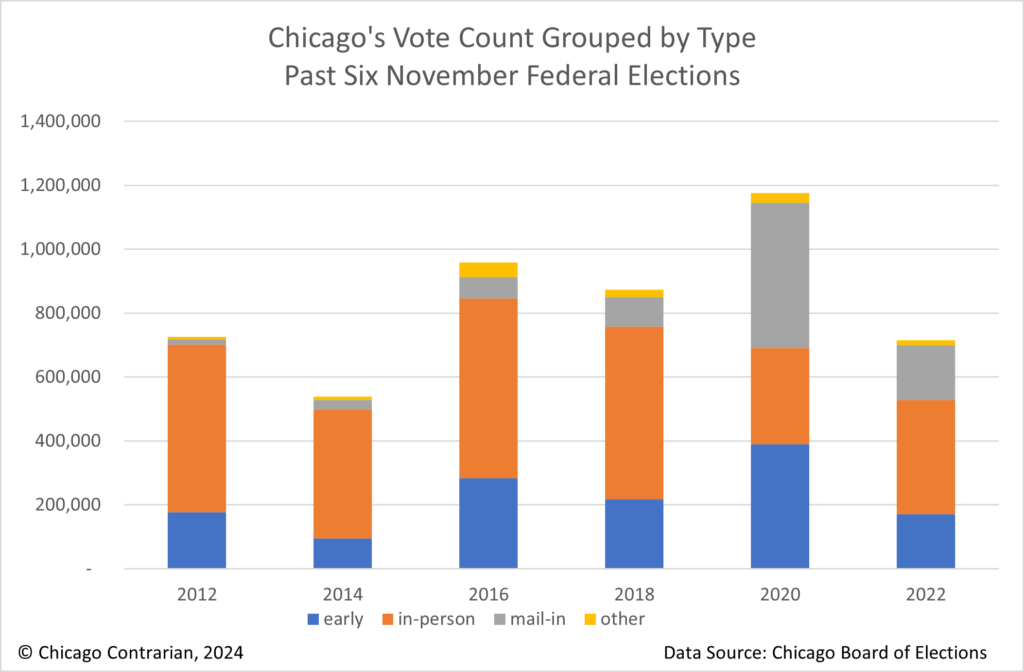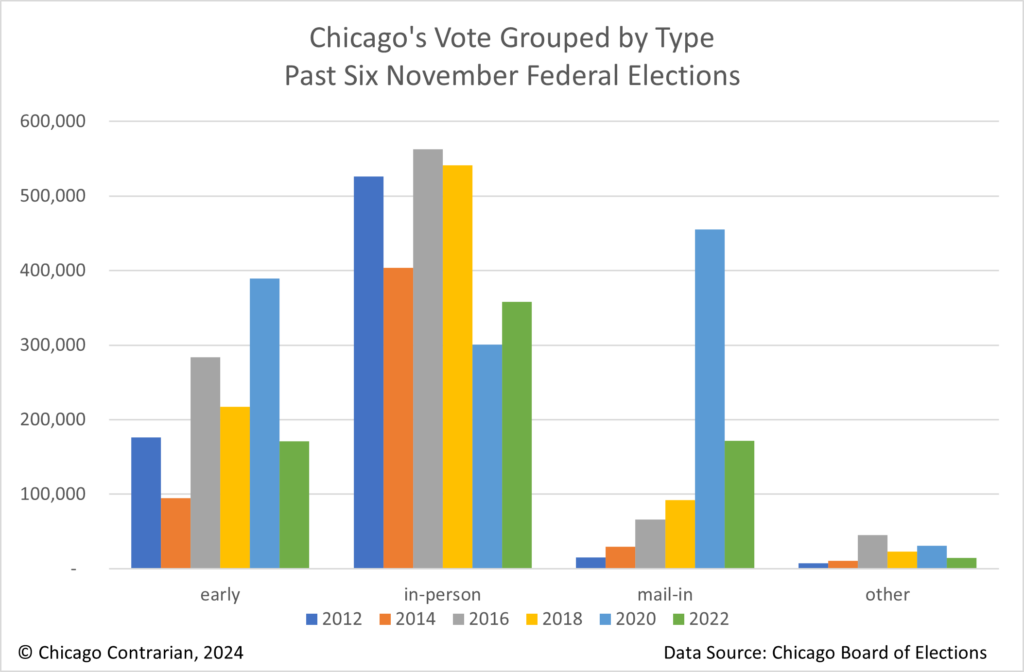It’s been unfixable for over a decade.
This is not a new problem:
“We are writing today to let you know that the pension crisis has grown so severe that it is now, unfixable,” said the letter co-signed by Miles White, chairman of the Commercial Club; Jim Farrell, chairman of the Civic Committee, and Ty Fahner, president of the Civic Committee and Commercial Club.
— Chicago Sun-Times, November 2012
That was 13 years ago, back when Miles White was the Chairman and CEO of Abbott Labs. Jim Farrell was the retired Chairman and CEO of Illinois Tool Works. Ty Fahner was a partner at Mayer Brown where he handled tax, bankruptcy, and securities matters. These were not dumb guys. To the contrary, they understood finance and were used to dealing with large numbers.
In a recent Chicago Contrarian article George Shay wrote, “First comes moral bankruptcy. Then comes fiscal bankruptcy.” Chicago has been both for a very long time.
Unfixable & Unknowable (The Problem Is the Plan)
Nobody can tell you how bad it really is.
In his article Shay says the total pension debt exceeds $35 billion. But it could easily be more. A lot more.
That number has been floated by Mark Glennon over at WirePoints. But bear in mind that analysis was based on the 2024 actuarial numbers from the pension funds themselves. Those numbers have historically been proven inaccurate in that they overstate anticipated returns and underestimate pensioners’ life-spans.
Further, the $35B absolutely doesn’t include the fallout of this month’s new state law dealing with Chicago’s Tier 2 pension system. That alone will likely add $11-15B (30-40%) to the total.
As if the situation is not bad enough, that number doesn’t include non-pension debt. The municipal bond debt another number shrouded in mystery. That is in no small part because it’s a perpetually moving target, but also because it depends on what numbers get included. Should the city’s numbers include the park district? How about CPS?
It’s no wonder that earlier this year Illinois Policy wrote that each Chicago taxpayer is on the hook for over $40,000. And that’s just to the city! If one was to add the debt from the county and the state every taxpayer owes over $80,000.
Its undeniable, the city is broke.
Potential Solutions
There are only five self-help tools available to thwart financial ruin:
1. Austerity: a rigorous cutting of expenses.
2. Raising Revenue: lots of new taxes.
3. Growth: new businesses and people increase the size of the pie.
4. Inflation: the ability to pay back old debt with cheaper dollars.
5. Bankruptcy.
An entire series of articles could be written about each… but to what end? The mayor and the city council have shown no interest in reducing spending. They also know the populace will not stand for new taxes. Chicago’s crime situation not only prevents growth, it contributes to people fleeing the city in record numbers. The mayor couldn’t create inflation if he tried as he’s unable to print money. That leaves old #5 as the only option.
It is worth noting that there is a non-self-help option: bailout. But as Shay correctly points out, that’s simply politically impossible. Illinois is in no better financial shape than the city. And on the national level, the responsible citizens across the country don’t have the stomach to pay for Chicago’s mistakes.
Who’s Going to Get Hurt?
For starters, it won’t be the rich. Money buys options. Just like when the public schools are terrible — those who can send their children to private schools — in a similar manner well-healed Chicagoans have options. One of those options is to simply leave. Even if a federal bankruptcy judge was to institute some sort of “Chicago income tax” those who can could simply walk away.
How about the truly poor? Well, they’re poor. They have nothing more to give (at least financially.) However, their continued suffering will only be exacerbated by a reduced police force and other services.
It’s easy to see who’ll be left holding the bag: the middle class, city workers, and maybe bondholders. (If the pension funds are holding municipal bond debt they will simply be obliterated. Payments to current retirees will cease. The housing market will collapse. It will be an extinction event for the city.)
It’s time to be honest with every police officer, firefighter, school teacher, and every other municipal worker:
- If you retire BEFORE the inevitable bankruptcy filing
You may – or may not – be able to keep your full pension. That is, perhaps the bankruptcy judge will deem that because you have already retired you should be allowed to keep what you are receiving. But then again, perhaps the judge will believe that you knew — or should have known — that the inevitable haircut was coming and give you one. - If you retire AFTER the inevitable bankruptcy filing.
You will not be receiving your full pension. PERIOD. FULL STOP.
Anyone who tells you otherwise is either stupid or lying (or both.)
The Blame Game
How we got here is kinda irrelevant. It’s only important to the extent that we don’t continue to repeat the mistakes of the past.
Yes, Daley bought the peace with the teacher’s union by selling the parking meters and the skyway.
Emmanuel got his buddies to refinance short term debt into long term debt before he saw the writing on the wall. He then took his chair and went home before the music stopped playing.
Lightfoot and Johnson are merely useful idiots who have IQs of a nice summer day. To his credit, last week Johnson made national news by finally observing that Chicago’s finances are at a “point of no return” without a massive tax hike. It’s nice that he points it out after cutting a deal with the teacher’s union and borrowing another $800 million.
At the end of the day, people get the government they deserve; we have no one to blame but ourselves.
So What Is One to Do?
- If you have the ability to do so, even if you have to move heaven and earth to make it happen, get out.
Oh yes, the kids are in school and the wife has this job and this and that. Get out. And baseball and soccer and dancing. Get out. And parents and friends and relatives. Get. Out.
That’s it.
If for some reason you happen to be feeling frisky or adventurous and choose to stay in the city, there may remain one single chance, one opportunity, however small of a possibility there may still be some way to save the city.
Back in February the Contrarian published a brilliant article by a genius author who wrote:
Consider a mayoral candidate whose sole position is that the city needs to be placed into “organized bankruptcy.” The idea is that an organized bankruptcy would be better than a disorganized bankruptcy or financial collapse whereby the city is unable to make either pension or bond payments. It’s the only thing the candidate talks about. When asked about crime, the politician answers: “If you think we have crime problem now wait until the city fails to make its payments to the police officers pension fund unless we get the city into organized bankruptcy.” Questioned on the environment? “The CTA can buy an entire new fleet of electric buses but in three years it won’t be able to pay anyone to drive them unless we place the city into organized bankruptcy.” On education: “CPS is probably top-heavy, with too many administrators, so the CTU should probably decide if they would like to take a 10 percent haircut with an organized bankruptcy now or 25 percent cut later with a financial collapse.”
Let’s be clear; Chicago has passed the event horizon.
From where we are there is no going back.
As Vallas, Mendoza and the others begin to elbow their way into your social media timelines, there is only one question you need to ask of them, “Will you commit to placing Chicago into organized bankruptcy within your first year in office?”
Anything short of an unqualified, “Yes, I fully promise to place the city of Chicago into bankruptcy even if I have to halt bond and or pension payments to make it happen” is an unacceptable answer.
Here’s the thing about bankruptcy; the sooner you file the less painful it is. Chicago should have filed over a decade ago when the three wise men foretold of its coming. It would have been much less painful then.
.





